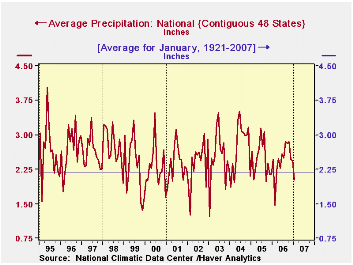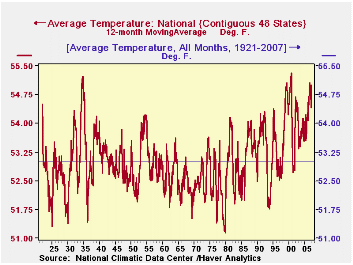 Global| Feb 08 2007
Global| Feb 08 2007U.S. Weather in January Not Far from "Normal", But Regions Show Wide Variations
Summary
With increasing attention to "climate change", some very simple data take on more prominence. The National Climatic Data Center, a division of the National Oceanic and Atmospheric Administration of the Commerce Department, maintains [...]

With increasing attention to "climate change", some very simple data take on more prominence. The National Climatic Data Center, a division of the National Oceanic and Atmospheric Administration of the Commerce Department, maintains temperature and precipitation records for the nation, regions and states. We wrote about these data last June, which was a particularly hot, dry month. Yesterday, the averages were published for January. Haver has for some time had these in both USECON for the national average and in REGIONAL for 9 regions and 48 states.
January's average temperature was 31.8°F, compared with an average since 1921 of 31.1°F. A year ago, which we recall as a mild winter, the January average temperature was 39.0°F. While this current period seems close to "normal", the regional breakdown shows considerable variation: of 9 regions, only one, the Northwest, was within a degree of its long-term January average, while three regions were chillier and five were warmer.
The amount of precipitation in January was 2.02", slightly less than the average of 2.18" since 1921. Last year and the year before were both somewhat wetter, at 2.46" and 2.65", respectively. Among the regions, there's a tendency toward dryness, as five regions had at least a quarter inch less precipitation than average, with two regions within 0.1" of average and two wetter than average.
When we examined these data in early July for June, we did so using Haver's DLX Excel add-in to make a spreadsheet full of June figures. The add-in entered the series codes we highlighted in DLXVG3 and traced out the range in which DLX would place the figures in the spreadsheet. So today, we simply revised that spreadsheet using a simple "replace" procedure to change the dates from yyyy06 to yyyy01 and adding a row to the bottom for 2007's entry. These two changes got us 87 years of January data for the 48-state total and 9 climate regions, along with means, medians and other statistics, within just a couple of minutes.
This array can help us tell quickly, for instance, that January 2006 was the warmest on record and was also the warmest for three regions, Central states, East North Central and West North Central. However, the warmest January in the South was way back in 1923 and in the Northeast, it was in 1932. What about so-called "global warming"? In the overall scheme of these things, 87 years isn't long. But in the third graph here, we show a 12-month moving average of the national temperature since 1921. This yearly average has clearly been rising since 1980, albeit from a low level then, and has been almost continuously above the long-term average since 1998.
| U.S. Weather | January 2007 | January 2006 | January 2005 | Averages of Januaries||||
|---|---|---|---|---|---|---|---|
| 2001-2007 | 1976-2000 | 1951-1975 | 1921-2007 | ||||
| Temperature (degrees F) | 31.8 | 39.0 | 33.2 | 33.39 | 30.93 | 30.73 | 31.08 |
| Precipitation (inches) | 2.02 | 2.46 | 2.65 | 1.99 | 2.25 | 2.14 | 2.18 |
Carol Stone, CBE
AuthorMore in Author Profile »Carol Stone, CBE came to Haver Analytics in 2003 following more than 35 years as a financial market economist at major Wall Street financial institutions, most especially Merrill Lynch and Nomura Securities. She has broad experience in analysis and forecasting of flow-of-funds accounts, the federal budget and Federal Reserve operations. At Nomura Securites, among other duties, she developed various indicator forecasting tools and edited a daily global publication produced in London and New York for readers in Tokyo. At Haver Analytics, Carol is a member of the Research Department, aiding database managers with research and documentation efforts, as well as posting commentary on select economic reports. In addition, she conducts Ways-of-the-World, a blog on economic issues for an Episcopal-Church-affiliated website, The Geranium Farm. During her career, Carol served as an officer of the Money Marketeers and the Downtown Economists Club. She has a PhD from NYU's Stern School of Business. She lives in Brooklyn, New York, and has a weekend home on Long Island.





